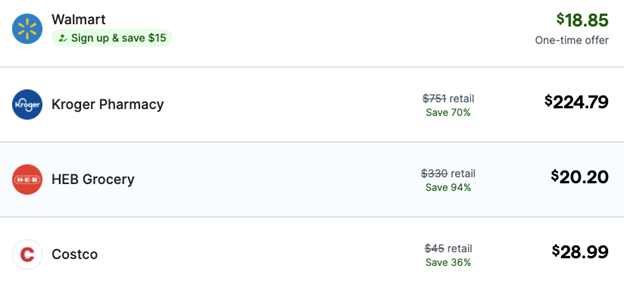A new study out by Prescryptive Health, a healthcare technology company, found that while 95% of people know they can comparison shop for drugs, very few do.
It’s unfortunate because shopping around can save thousands of dollars annually since drug costs vary widely by pharmacy. Take modafinil, the generic version of Provigil, a sleep apnea medication, as an example:


The difference in pharmacy alone is more than an order of magnitude – from $18.85 to $224.79. Most prescription drugs (86%) are purchased at retail pharmacies, but the prices they charge are a reflection of their negotiating prowess with drug manufacturers or that of their Pharmacy Benefits Manager (PBM).
In addition, the markup on the medication is very different depending on the pharmacy. An independent survey of retail pharmacy representatives showed that 93% of respondents were focused on offering “competitive prices,” while only 16% tried to offer the “lowest cost.”
Transparency
Transparency about cost is important to consumers. Prescryptive Health’s study uncovered that 90% of survey respondents wished they knew the price of their medication before getting to the pharmacy. Sticker shock can be debilitating, and few people are prepared to manage a high pharmacy bill while standing at the register with a line of strangers behind them. This is the point where the healthcare system fails patients and their doctors; it’s a lose-lose situation.
Seventy-three percent of consumers surveyed said they would prefer to have a conversation with their prescriber about lower-cost drug options if they already knew that the prescription would be too expensive. Lower-cost options are less attractive or worth the time to discuss in the absence of cost information, which strongly suggests that better visibility into drug prices is needed. People want to know if there is a price barrier before proactively looking for affordable alternatives.
While transparency is important at the point of care, what about people who already have a recurring prescription? The refill area has proved difficult for Real-Time Benefit Tools (RTBT)s, discount cards, and other solutions because the refill tends to be automated. The price can change dramatically even when the prescription remains the same because formularies are rewritten at least once a year, and often there are mid-year changes. This means that anyone with a chronic condition may be losing out on savings unless their health plan or employer utilizes a health tech company like RazorMetrics.
Founded by Physicians
RazorMetrics was founded by physicians to help physicians be a valuable part of the drug cost savings process. Health plans and self-funded employers put their formularies to work by bringing physicians into the fold with RazorMetrics. Their process is simple and requires no extra clicks in the EHR and no external programs or apps to access. Switches are straightforward and easy to make, and the entire process stays within the normal clinical workflow. For more information on how to save on your prescription drug benefits, contact RazorMetrics today.




